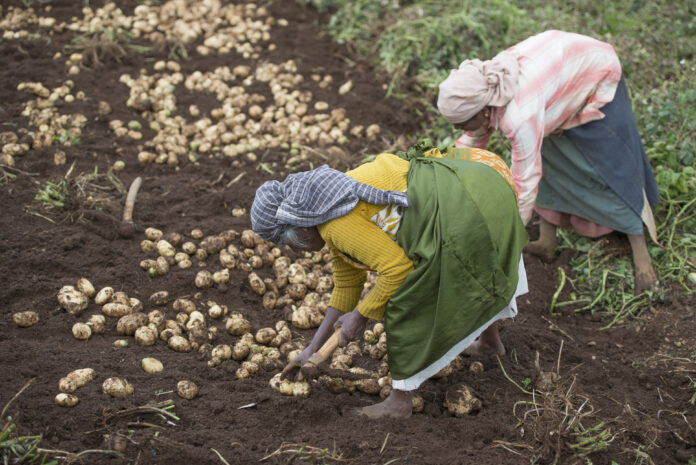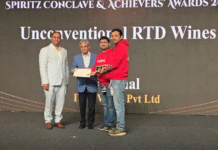It now goes without saying that India’s food processing sector has immense potential. The potential has already been proven, as suggested in different reports and projections, which are all unanimous about one aspect – it is now time to grow and get going.
Some stats first. According to IMARC (International Market Analysis Research and Consulting Group), India’s food processing industry has witnessed rapid growth in the recent past, with the sector emerging as a driving force of the economy. The food processing industry in India reached a value of US$ 336.4 billion in 2023 and is expected to reach US$ 735.5 billion, at a CAGR of 8.8% during 2023-2032, Imarc says.
A recent Deloitte-FICCI report says India’s food processing sector contributes approximately 7.7% to India’s manufacturing gross value added (GVA), supporting around 7 million jobs directly and indirectly – enabling rural industrialization and reducing post-harvest losses. The sector reflects India’s economic rise, marked by the country’s rank as the fifth-largest economy and a doubling of per capita income to Rs1.97 lakh over the past nine years.
According to government data, the food processing sector emerged as an important segment of the Indian economy in terms of its contribution to GDP, employment and exports. During the eight years ending 2022-23, the sector grew at an average annual growth rate (AAGR) of around 5.35%. The gross value added (GVA) in the sector also increased from 1.61 lakh crore in 2015-16 to 1.92 lakh crore in 2021-22.

GVA is a productivity metric that measures the contribution of a corporate subsidiary, company, or municipality to an economy. In other words, it is the measure of the value of goods and services produced in an area, industry or sector of an economy.
The Deloitte-FICCI report says India’s food processing industry is no longer just a value-addition engine. It is evolving into a value-creation powerhouse—bridging farm to fork, aligning with consumer aspirations, and positioning India as a global leader in agri-food innovation.
A report by the Indian Chamber of Food and Agriculture says India is one of the largest countries in terms of food production, processing, supply and consumption. India’s food market is ranked sixth in the world and fifth in production, consumption and export. The food processing sector, it says, is projected to rise to US$ 535 billion by 2025-26.
Govt push for sunrise industry
India’s food processing industry has undergone rapid transformation, driven by its vast agricultural base, rising domestic demand, and supportive government policies. The government says India is poised to emerge as a global leader in the food processing sector, with an impressive growth trajectory.
The agriculture sector forms the backbone of the food processing industry as India is one of the largest producers of fruits, vegetables, millets, tea, and food grains as well as milk and livestock globally.
Driving this growth is the government of India’s focused approach toward formalizing and expanding the food processing sector, which has encouraged a host of startups to venture into this sunrise sector, as seen in a host of food processing shows and exhibitions such as Aahar, Anuga Select India & Anuga FoodTec India, World Food India, Sial India, or SUFALAM 2025, a two-day start-up forum for aspiring leaders and mentors, and India Food Manufacturing Summit 2025.
The ministry of food processing industries launched several initiatives to reduce post-harvest losses, increase value addition, and generate employment. Flagship programs such as the mega food parks scheme, integrated cold chain initiatives, and the production-linked incentive (PLI) scheme for food processing were major drivers of this sector.
The agriculture and food processing value chain, which makes up nearly 30% of the national food market, is gaining traction due to rising rural demand, digitization and policy support. India’s agricultural exports reached US$ 48.2 billion in FY24, highlighting the sector’s export potential and importance in the global food economy, the Deloitte-FICCI said.

“India’s agri and food processing sector is on the brink of a transformative leap, where tradition meets cutting-edge technology to build a future-ready food ecosystem. Consumer demand is shifting towards clean-label, protein-rich and gut-friendly foods, driving a structural evolution in how India consumes food. India is poised to lead the global narrative on health-driven, tech-enabled and inclusive food systems, fueled by advancements in AI, IoT and blockchain,” said Anand Ramanathan, partner & consumer industry leader, Deloitte South Asia.
The Economic Survey says India is the largest producer of milk and the second largest producer of fruits, vegetables, and sugar, and thus the availability of reasonably priced agricultural inputs, the vast labor force, and continuously growing consumer demand provide the essential elements for a robust food processing industry. “The sector also plays a vital role in reducing the wastage of perishable agricultural produce, enhancing the shelf life of food products, ensuring value addition to agricultural produce, and incentivizing diversification & commercialization of agriculture.”
Consumer preferences and premiumization
Shaping the processed food market is changing consumer food choices, which are evolving beyond traditional staples to include protein-rich, convenient, and health-oriented offerings. Packaged food consumption has risen sharply, with spending tripling from 9% to 23% of household food budgets between 2000 and 2023.
A top consumer products company has seen a 3% increase in sales contribution from premium products and more than 70% of their new product launches in the last two years have been in the premium segment, indicating a strategic focus on higher-value offerings. Similarly, a large biscuit manufacturer has shifted approximately 60–65% of its new product launches to the premium segment, up from 40 percent before Covid-19, highlighting a strategic pivot towards higher-end offerings, the Deloitte report says
Premiumization is on the fast track. Premium products constitute 27% of the overall FMCG market, yet they contributed an impressive 42% to the sector’s total growth in India. This outsized influence underscores the accelerating premiumization trend, with consumers increasingly favoring high-quality and aspirational products. Companies are launching new products to suit their preferences with high protein, low sugar, clean-label ingredients, and functional benefits such as gut health. Indigenous superfoods such as millets and makhana are also seeing a resurgence, spurred by government campaigns and growing consumer interest in preventive nutrition.
Premium brands have shown resilience, with price adjustments helping to maintain revenue growth despite rising raw material costs. This focus on premiumisation has driven growth for these brands, while mass market products have struggled, resulting in a K-shaped recovery within the industry, the Deloitte-FICCI report says.
Challenges and way forward
In spite of its rapid growth, the food processing industry faces a few challenges that need to be addressed for its uninterrupted growth. Infrastructure bottlenecks, such as a shortage of cold chain and storage facilities top the list. More than 30% of agricultural produce is lost due to inadequate cold chain infrastructure, the India Brand Equity Foundation noted.
The NITI Aayog has estimated annual post-harvest losses to be around Rs 90,000 crore (US$ 10.79 billion). Additionally, poor connectivity and the absence of all-weather roads lead to erratic supply chains, making it difficult to transport perishable goods efficiently. This situation increases costs and reduces the overall quality of food products.
The other issues are limited access to technology for small and medium-sized enterprises; regulatory and quality compliance issues for exports; and the need for skilled labor and better R&D for innovation. The National Skill Development Corporation estimates a requirement to skill 17.8 million individuals in the food processing sector by 2022, one report says.
“Innovation is a necessity to enable India’s food processing sector to respond to consumer trends around health, wellness, convenience and indulgence. By integrating market insights, science, traditional wisdom and cutting-edge technology, we can reimagine food through more healthy, functional and sustainable solutions, thereby positioning India as a leader in progressive food innovation,” suggests Sunil Nair, B2B commercial head and R&D leader, Food South Asia, Cargill.
Speaking along similar lines, the Vikasit Bharat by 2047 report on the role of the food processing sector says significant investment is needed in rural infrastructure such as grading and packing centers, storage facilities, transportation, and testing laboratories to aid the food processing industry. Increasing agricultural output without investing in processing facilities can harm the earnings of farmers and cause rural distress, it cautioned.
The report lays stress on strong supply chains that connect farmers to processing and marketing as well as strengthening primary processing at the farm level, including sorting/grading, packaging, and drying. An integrated cold chain can transform India’s rural economy.
The Deloitte-FICCI report lays down a road map for the sector to fully realize this potential, which could help drive the next phase of transformation in the sector. In tune with other reports, it suggests driving innovation to align with consumer preferences, increasing rural market presence by offering affordable premium products, creating localized SKUs, and establishing robust distribution networks based on regional insights and aspirations.
It recommends prioritizing health and superfoods by integrating Indian ingredients such as millets and turmeric into functional offerings validated for mainstream wellness trends, as well as suggests fostering public-private collaboration to streamline regulations, support infrastructure development and provide targeted support to MSMEs and start-ups.
The sector can boost food exports by enhancing value chains to meet global demand for wellness-focused, culturally rooted products, while strengthening India’s food brand; and use technology across operations to improve agility, sustainability and competitiveness in line with Industry 5.0 principles. By aligning with these focus areas, India could build a resilient, consumer-driven food processing ecosystem with global relevance and transformative domestic impact, the report concludes.
Sunil D’Souza, managing director & CEO, Tata Consumer Products, sums it up, “India’s food processing sector remains vastly under-leveraged. And we can see the large opportunity it presents for our business to serve our consumers more effectively. Focused investments in infrastructure can catalyze value creation, streamline supply chains, and significantly reduce food loss across the agri-value chain, thereby creating a powerful multiplier effect for agriculture, retail, and export growth.”
IndiFoodBev — authentic, impactful and influential
An English-language food and beverage processing and packaging industry B2B platform in print and web, IndiFoodBev is in its third year of publication. It is said that the Indian food and beverage industries represent approximately US$ 900 billion in revenues which implies more than 20% of the country’s GDP. Eliminating the wastage on the farmside can help to deliver more protein to a higher number of the population apart from generating sizable exports. The savings in soil, seeds, water, fertilizer, energy and ultimately food and nutrition could be the most immense contribution that country is poised to make to the moderation of climate change.
To improve your marketing and grow sales to the food and beverage processing and packaging industry, talk to us. Our research and consulting company IppStar [www.ippstar.org] can assess your potential and addressable markets in light of the competition. We can discuss marketing, communication, and sales strategies for market entry and growth.
Suppliers and service providers with a strategy and budget for targeted marketing can discuss using our hybrid print, web, video, and social media channels to create brand recognition linked to market relevance. Our technical writers are ready to meet you and your customers for content.
The second largest producer of fruit and vegetables in the world is continuously expanding processing capacities and delivery systems with appropriate innovative technologies. We cover product and consumer trends, nutrition, processing, research, equipment and packaging from farm to thali. Get our 2025 media kit and recalibrate your role in this dynamic market. Enhance your visibility and relevance to existing markets and turn potential customers into conversations. Ask for a sample copy of our bi-monthly in print or our weekly IndiFoodBev eZine each Wednesday.
For editorial info@ippgroup.in — for advertisement ads1@ippgroup.in and for subscriptions subscription@ippgroup.in
Naresh Khanna – 10 February 2025
Subscribe Now












